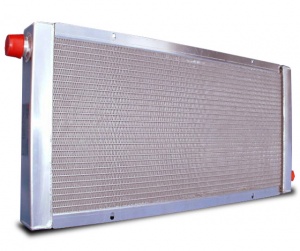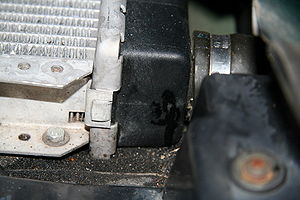Difference between revisions of "Radiator"
| Line 5: | Line 5: | ||
{{clr}} | {{clr}} | ||
| − | == | + | ==Leaks== |
[[Image:Oem rad end tank leak.jpg|thumb|left|Drivers side end tank leaking under pressure]] | [[Image:Oem rad end tank leak.jpg|thumb|left|Drivers side end tank leaking under pressure]] | ||
| − | The most common fault with the OEM radiator is cracking of the plastic end tanks. The first signs of failure are drops of coolent on the windscreen, either drivers or passengers side, but castrophic failure of the end tanks has been known. | + | The most common fault with the OEM radiator is cracking/spliting of the plastic end tanks. The first signs of failure are drops of coolent on the windscreen, either drivers or passengers side, but castrophic failure of the end tanks has been known. |
| + | {{clr}} | ||
| + | |||
| + | Quite often the passenger side hose is poorly connected (because it is difficult to do) and sometimes the bleed screw can leak. | ||
| + | |||
| + | ===Indication of HGF=== | ||
| + | Its been suggested in the past that a blown radiator can indicate imminent HGF. However, the header tank cap is normally the first to vent when the system is pressurised since it only requires approximately 1 bar. The radiator is designed to operate at pressures a lot higher than this and the cap acts as a fuse. The OEM radiators seem to have a problem with their manufacture where the main core is bonded to the top/bottom and leaks are all too common. | ||
==Aftermarket Upgrades== | ==Aftermarket Upgrades== | ||
Revision as of 21:24, 22 August 2006
The standard OEM Elise radiator is another weak point in the cooling system. Although it is lightweight, it has plastic end tanks which are prone to expanding and leaking under pressure.
Unfortunately you need to remove the front clamshell before you can replace the radiator.
Leaks
The most common fault with the OEM radiator is cracking/spliting of the plastic end tanks. The first signs of failure are drops of coolent on the windscreen, either drivers or passengers side, but castrophic failure of the end tanks has been known.
Quite often the passenger side hose is poorly connected (because it is difficult to do) and sometimes the bleed screw can leak.
Indication of HGF
Its been suggested in the past that a blown radiator can indicate imminent HGF. However, the header tank cap is normally the first to vent when the system is pressurised since it only requires approximately 1 bar. The radiator is designed to operate at pressures a lot higher than this and the cap acts as a fuse. The OEM radiators seem to have a problem with their manufacture where the main core is bonded to the top/bottom and leaks are all too common.

